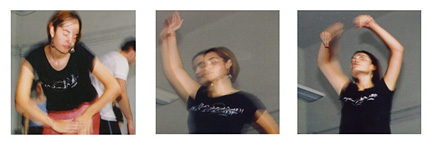Detail
ACTIVITY

Step 1. Observe and Move: Ask dancers to look around the room and find three things they haven’t noticed before. Call on a few participants to name the objects or aspects of the environment they are noticing: an air conditioning duct, the curtain fixtures, the exit sign. Choose one of these objects. Direct the group’s attention to it, and ask everyone to make a movement that reflects, encompasses, embodies, traces, reacts to, or enacts a function of that detail. Allow everyone 30 seconds to develop a movement or physical shape. Invite a few people to show their solutions, and get the group to reflect on the strategies they used to derive movement and the features they observed in the solutions of others.
Step 2. Deeper Detail: Next ask dancers to look carefully at the object and try to describe it in exact terms: Call on someone to describe out loud what he sees: Observing the air conditioning duct he might say: “Let’s see… I count eight screws, there’s a small lever, two sets of louvers pointed in opposite directions. On the left a couple of the louvers are dented so they curl down. One corner is bent and the paint is chipping where it’s screwed into the wall.” Restate the specifics of this description. You may wish to draw attention to particular features that make it rich with movement potential, particularly verb phrases like “pointed in opposite directions,” “dented,” “curl down,” “chipping,” “screwed into the wall.” These action ideas are important because as dance-makers we are looking for the kind of detail that makes us have to move. Now ask dancers to repeat the exercise of giving movement to this physical evidence, this time based on the more detailed description. Again, allow 30 seconds for this task.
Take a few minutes to share some of these solutions and reflect on them. Ask dancers to note the difference between the first experience of making movement and that based on the more detailed description. Which was more fun to do? Which made more interesting movement? Which generated an idea that might be worth expanding upon? Usually the response will draw attention to the richness of working from the more deeply observed detail.
Step 3. Observe Imagination: Now take a sentence: It can be based on immediate circumstances or it can draw on a familiar story. It should call on participants to imagine something that can’t be observed in the immediate environment. For purposes of concentrating on the technique it’s best to choose something familiar but not especially fraught with emotion or a sense of importance (such as scripture or a civil rights speech). An excellent choice is “Little Red Riding Hood went through the woods to visit her grandmother.”
Ask for the details in this statement. Most often people will reply with words from the sentence, or the most familiar images from the story: “woods,” or “Red Riding Hood’s cape.” Restate the sentence and ask participants to picture the scene in detail. Then ask everyone to take two minutes to write down all the details they think of. Have the group listen ask as few participants read off their lists. Typically lists will be an inventory of general elements like trees, gravel, sunlight.
Step 4. Probe for Detail: As practiced in step 2 with concrete details in the room, the task again is to observe for more specific detail, this time inside the mental image. Demonstrate these principles by interviewing a participant who has shared his list. What do the trees look like? What kinds of trees are they? Describe their color, texture, and such components as bark, roots, leaves. Replies might include “The trees are clumped together. They have low-hanging branches,” or “It’s that spongy sort of bark with deep crevices.” Draw attention to verbs and adjectives (“clumped…spongy”) that provide a concrete source for movement ideas. Also point out the spontaneous gesture that usually emerges as people attempt to clarify the images. Smells and emotions may also come up in these interviews. While these are less likely to be the direct source of movement ideas, dancers can be directed to think about these ideas as suggesting qualities for movements.
Step 5. Describe and Develop: Now ask dancers to take one of the details on their list and take another two minutes to write a description, thinking about some of the probing questions used in the interview. Now ask dancers to look at the descriptions they have developed, to choose several details, and take five minutes to develop a movement phrase from these details. Dancers may need to be encouraged to explore space; the detail concept can make some movers feel as though they must limit themselves to small movement.
Step 6. Reconnect: Once dancers have their phrases set, ask them to practice while speaking the originating sentence “Little Red Riding Hood went through the woods to visit her grandmother.” Have a showing, allowing the group to observe some of these text-and-movement phrases. Ask for observations.